Induction Stove – Everything You Need To Know
What Is An Induction Stove?
An induction stove, cooktop, stovetop, or cooker is a type of stove powered by electricity but does not use traditional heating methods. While induction stoves look quite similar to regular electric stoves, they function differently. The cookware on an induction cooktop gets heated up through electromagnetism, while the cooking surface remains cool.
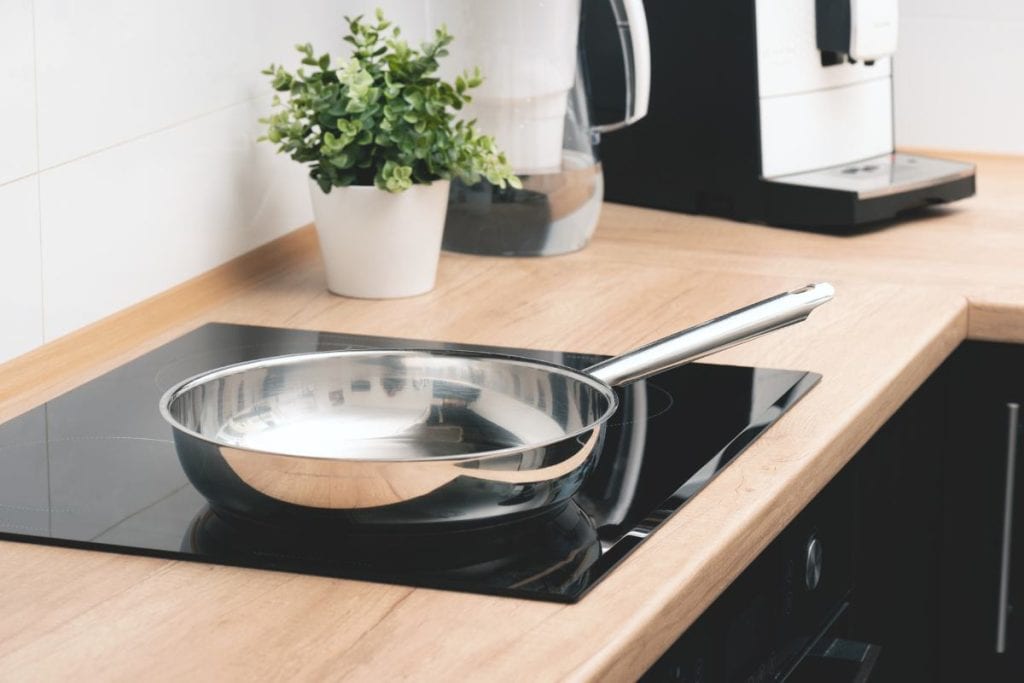
With precision in temperature control, induction stoves are more energy efficient than traditional stoves. Now when we talk about induction, it’s not only a small cooktop with one cooking zone. The newer and advanced models now have multiple cooking zones in one stove. And if you are willing to spend a little more, you can have your own sleek and in-built induction cooking hob set on your countertop.
In this article, we will discuss all the aspects of this trendy new alternative to your traditional gas stove. Be it the different types of induction stove or their pros and cons, and we are here to answer all the possible questions you may have about this simple yet miraculous technology.
Types Of Induction Stoves
Single Element Induction Stove
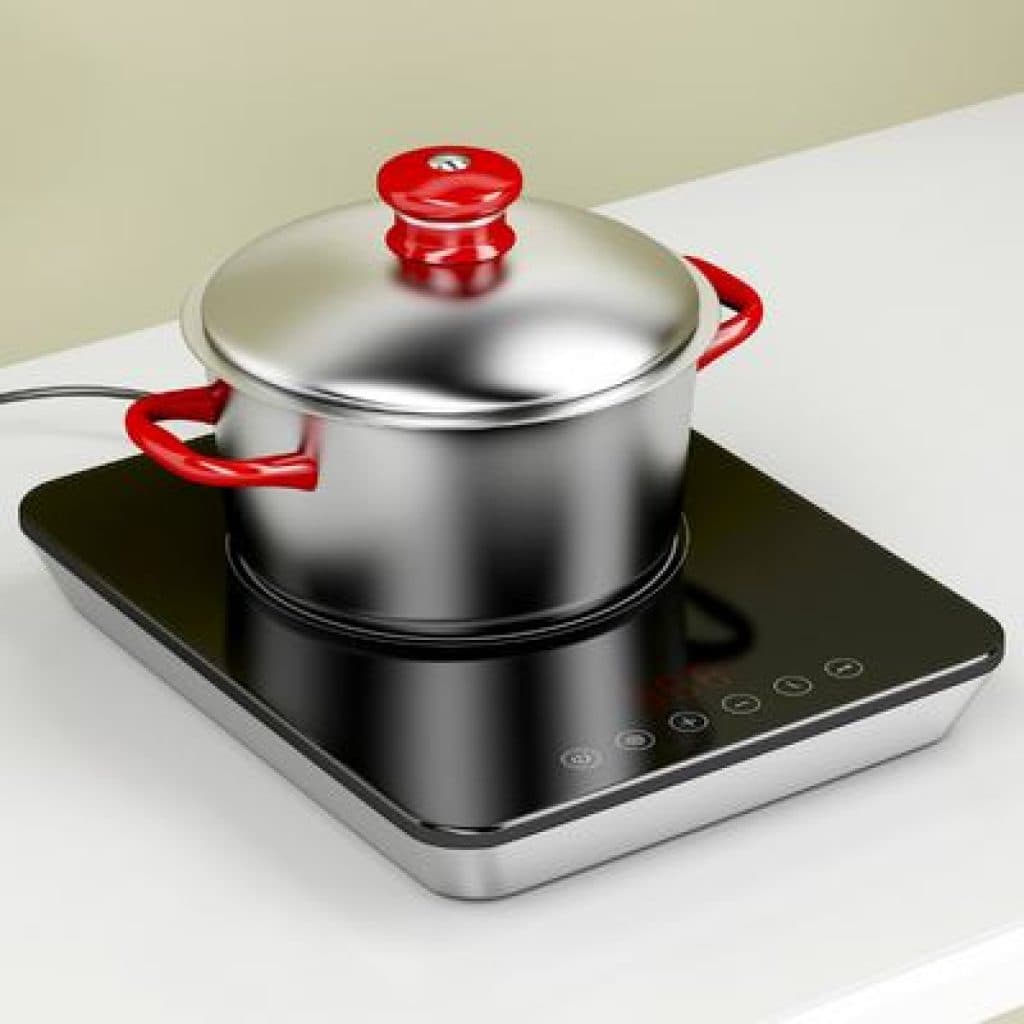
In such induction cooktops, only a single cooking zone is available for the cookware to be placed. The maximum wattage of a single element induction stove is 2200 Watts, and they operate at 220-230 Volts.
Similar to one burner gas stove, you can’t use these units to prepare different dishes simultaneously. Due to their compact size, single-element induction stoves are portable and comparatively less costly. These space-saving cooking units are ideal for limited cooking.
Multi-element Induction Cooktop
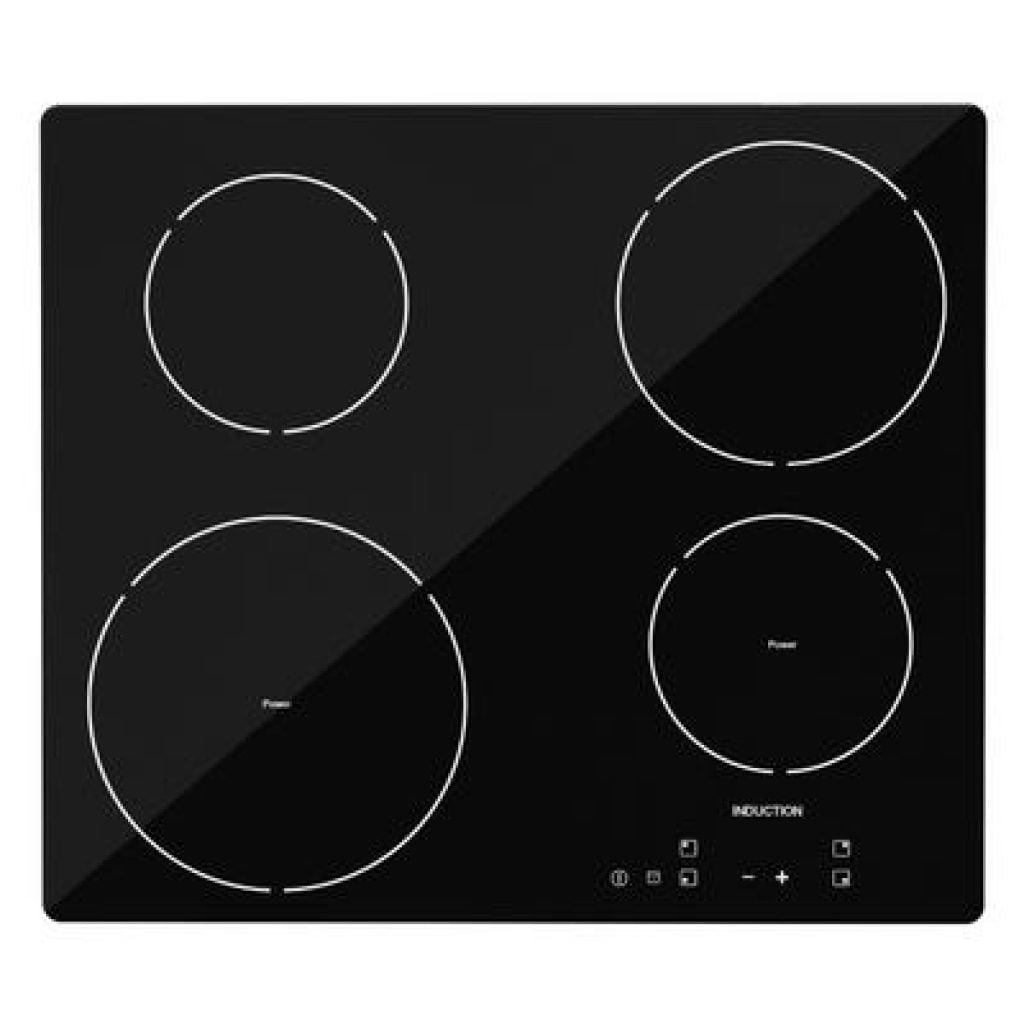
As the name states, there are several cooking zones in multi-element induction cooktops. When it comes to expenses, naturally, it’s higher considering the efficiency of a multi-element induction stove.
This type of induction stove is ideal for professional kitchens or big families. Thanks to the multiple induction zones, different dishes can be cooked simultaneously. For the same reason, their wattage and power are substantially higher, going up to 3600 Watts and 220 Volts.
Built-in Induction Hob
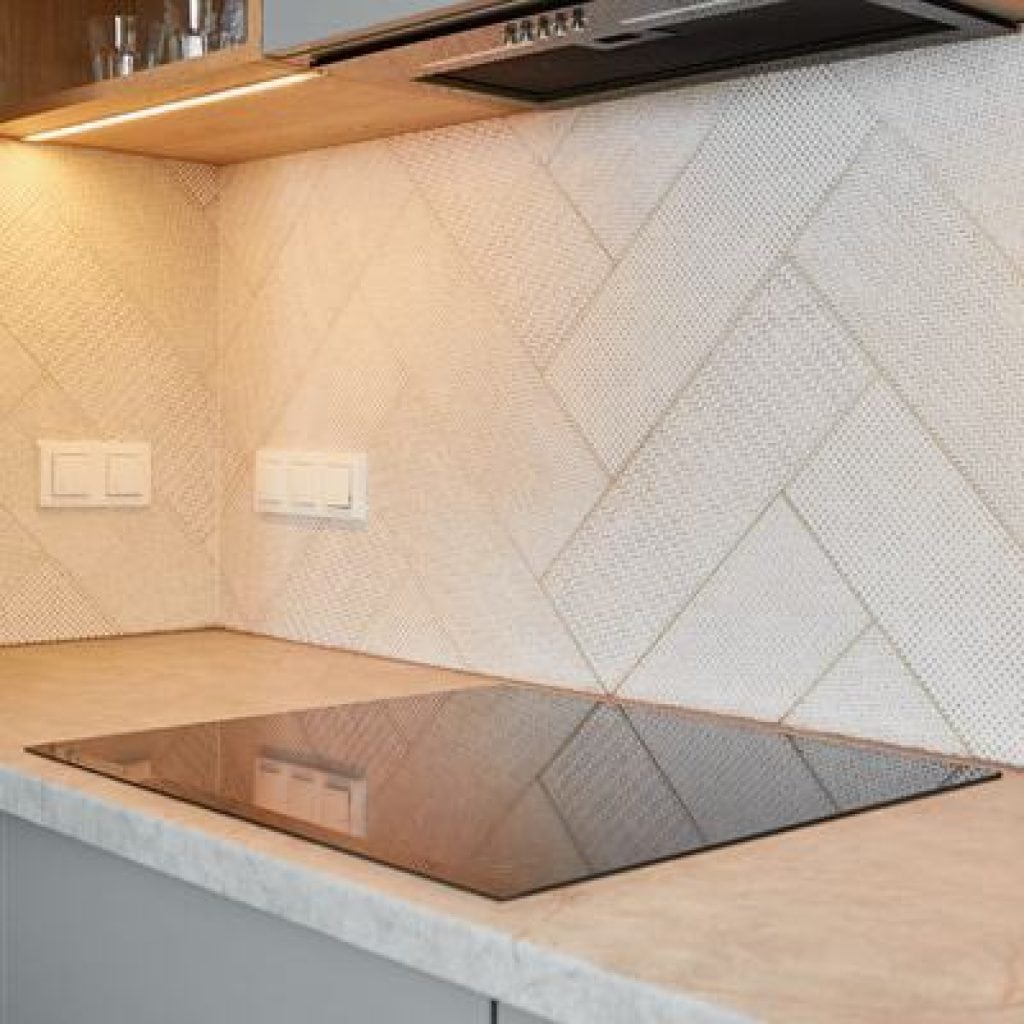
Built-in induction hobs are nothing but multiple-element induction cooking units built-in on the kitchen countertops. Such induction hobs can be customized according to the size of your cooktop. You can choose to have as many cooktops as you need on your countertop.
However, it must be installed carefully to fit the countertop perfectly. Otherwise, both using and looking at it won’t be pleasurable. Getting this variation of an induction cooktop can be a costly affair involving expensive installation and customization. Built-in induction hobs look sleek, bringing a certain sophistication to your kitchen.
Parts Of An Induction Cooktop
1. Cooking Surface
Typically made of a glass-ceramic material, the cooking surface of an induction stove is a poor heat conductor. Hence, most heat remains on the cooking pot instead of getting transferred through the bottom to the surface. This gives induction cooktops one of their best USPs – the surface remains substantially cooler and can be safely touched.
A ceramic top induction stove uses a lot of energy to heat up the cooking zones, while glass top induction hobs are more energy efficient and durable. The cooking surface of an induction stove is extremely smooth, making it very easy to clean.
2. Induction Coil
Also known as the spark coil, the induction coil is the soul of induction stoves. It works on the principle of mutual induction that generates heat on the cookware by changing electromagnetic fields.
The induction coil of induction cooktops is made of copper and is located underneath the cooker surface. When a pot is placed over the cooking zone, the stove converts the electrical energy to heat energy by the induction coil to the cooking pot.
3. Temperature Sensor
A temperature sensor is a safety measure to ensure that the cookware does not overheat. Placed in contact with the underside of the glass cover plate of the stove, it senses the temperature in the heating area where the cooking vessel is placed over the magnetic coil.
4. DC Fan
While not as much as gas or electric stoves, induction stoves need ventilation. Steam, grease, residual heat, and smoke are bound to be produced while cooking. The cooling fan provides ventilation and prevents such residues from building up in the internal system.
DC fan or the cooling fan’s aim is also to help minimize the damage to the internal system of the stove. With its assistance, the control boards remain safe from overheating.
5. Control Panel
Induction stoves have a control panel instead of knobs like gas stoves. The control panel can be of three types: touch control, button control, and gesture control. It also features a small display where the temperature, cooking mode, and time are displayed.
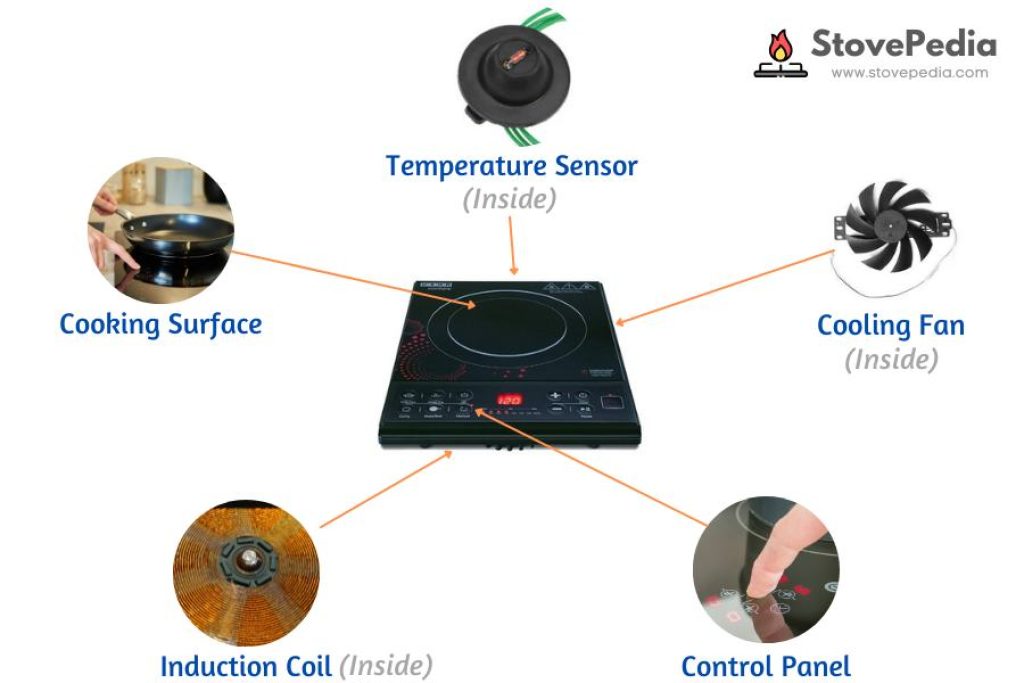
How Does An Induction Stove Work?
Instead of external flames, Induction cooktops use electromagnetism to heat up the cooking vessel. An essential requirement for compatible cookware for induction stove is to be made of some ferromagnetic metal like cast iron or steel. Copper or aluminum pans would not work unless they have additional magnetic layers added onto the bottom.
An induction cooktop contains a coil of copper wire underneath the ceramic plate. When the user places cookware on top, it generate variable electromagnetic fields. The resulting oscillating magnetic field induces a magnetic flux, producing an eddy current in the cooking vessel. Thus, the cookware acts like the secondary winding of a transformer, and as the energy transfers directly to the pot and heats it up.
Performance Of Induction Cookers
One of the best things about induction stoves is that they are more cost-effective than gas or electric stoves. But to measure that, we need to be clear on three points- wattage, power consumption, and efficiency.
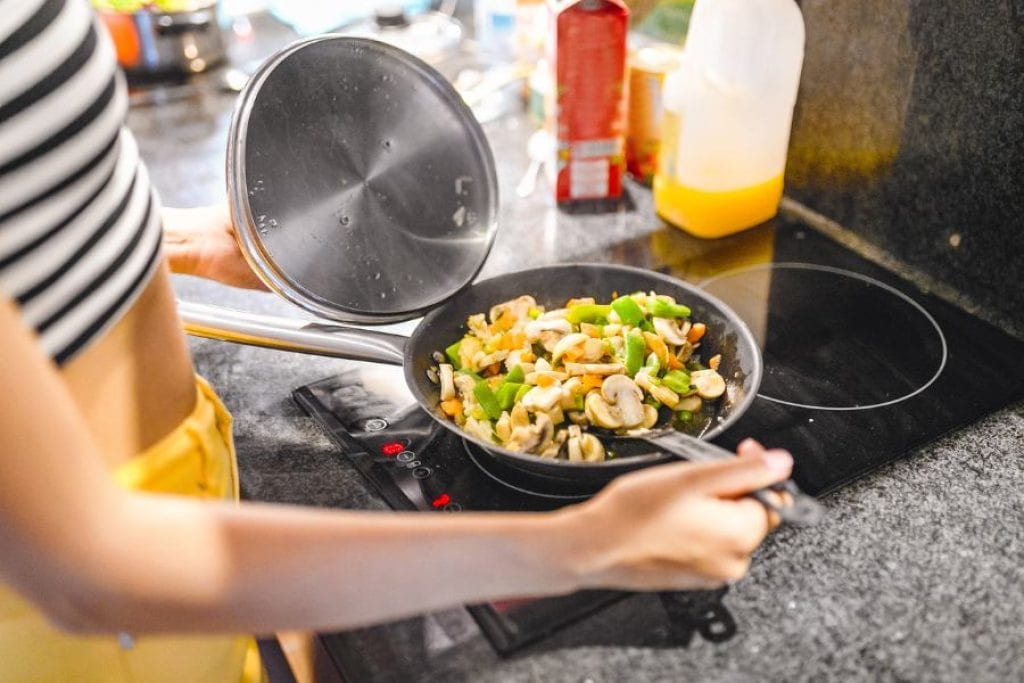
Wattage
On average, the rated wattage of an induction cooktop is somewhere between 800 watts to 3000 watts. This is much higher than the majority of the household appliances. The higher the wattage, the faster the heating and the lesser the cooking time. The higher wattage is one of the reasons why induction stoves are efficient is quick heating.
Power Consumption
We need to remember that Power Consumption= Wattage * Run Time. If the cooktop runs with 2000 watts for an hour, it will consume 2000 watt-hour or 2 kWh or two units of electricity. Use the induction stove power consumption calculator, which is based on the wattage, run time and tariff, to know the energy consumed and electricity bill for daily, monthly and yearly usage.
For an electricity tariff of ₹8/unit, it will cost you ₹16, considering 100% working efficiency of the stove. So, if a user wants to boil 10 liters of water, the induction stove consumes 1.04 kWh (kilowatt-hours) on induction compared to 0.012 units in gas.
Efficiency
When choosing a cooking appliance, most people instinctively go for gas or electric stoves. But induction stoves are much more efficient when it comes to time and consumed energy. Other cooktops like electric or gas stoves work on thermal conduction.
But on an induction cooktop, the food is cooked directly by inducing a resistive electric current in the cooking vessel itself. This causes 85% to 90% of the heat used for cooking, while in the cases of gas or electric stove, only 60% to 70% of the total generated heat is actually used for cooking.
Control Panels On Induction Stoves
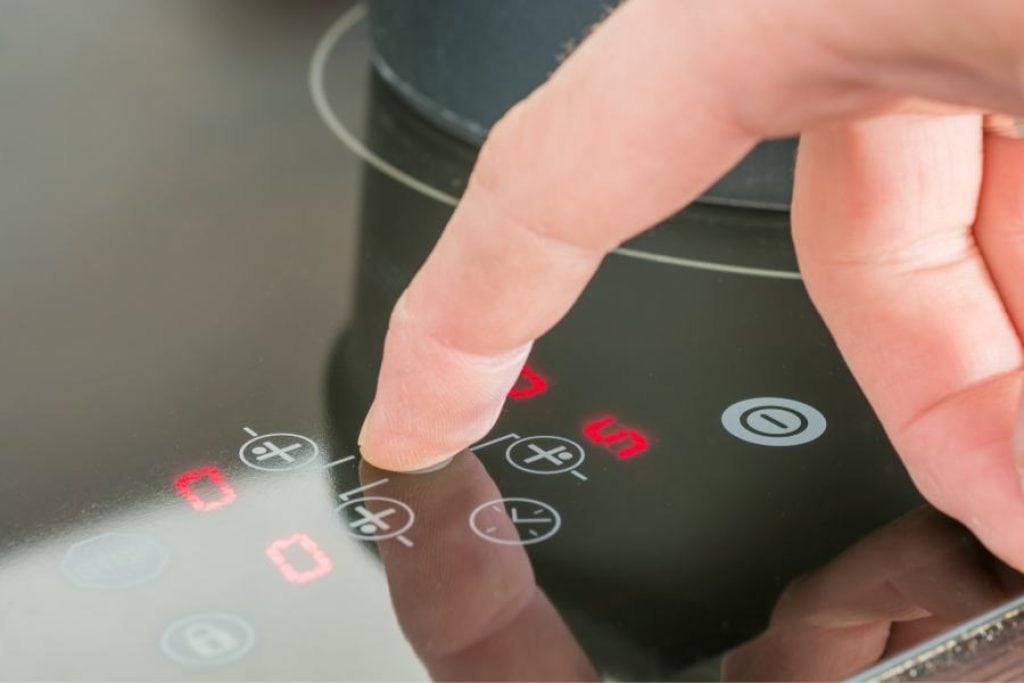
- Button: Button control panels are the most common when it comes to old induction stove models. The best part about push button control panels is that it works even if the control panel gets wet. Mostly, induction stoves with such control panels cost less than touch or gesture induction cooktops.
- Touch: Typical to moderate to high-end induction stoves, touch control panels are sleek and easy to clean. A touch control panel is mostly used on all modern induction cooktops. Such stoves are also easier to use.
- Gesture: Thanks to the wonderful modern technology, induction stoves are also available with gesture-operated control panels. With such a system, there is no need even to touch the stove. Just place the pot and control the cooktop with a swipe of your hand. While induction stoves with gesture control are more expensive, they surely add a ‘spark’ of efficiency to your kitchen.
Induction Cooking Functions and Preset Menus
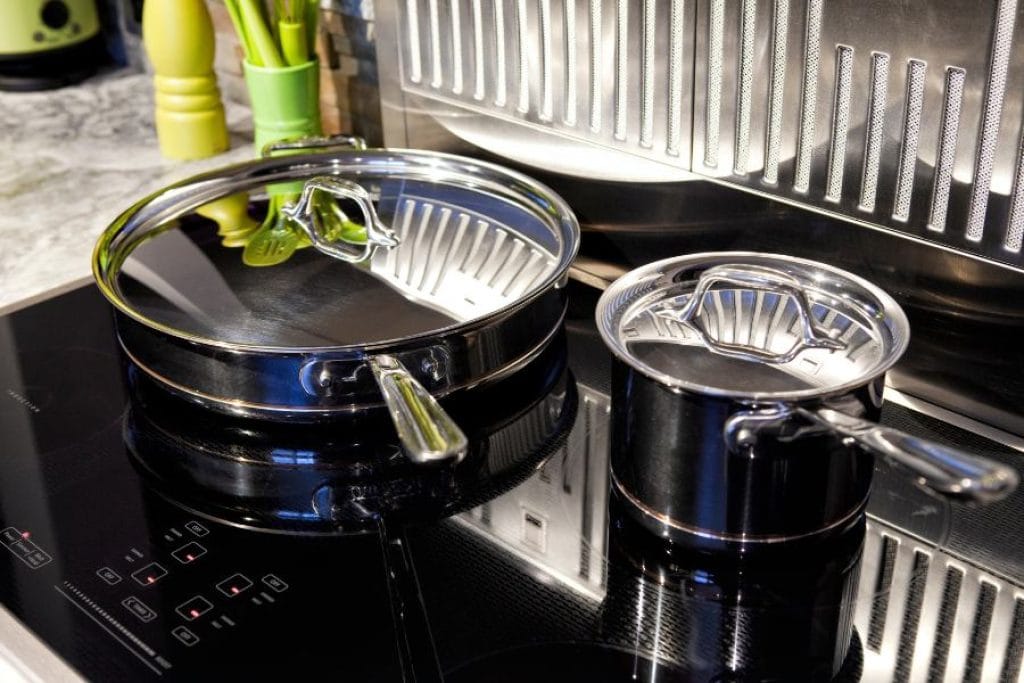
One of the key perks of induction stoves is the advanced functions that make them easy to use. Many reputed brands have also released induction stoves with cooking functions suited for Indian cuisines. Let’s look at some of the functions that make our kitchen work easier.
Preset Timer
Modern induction stoves include a unique preset timer. All you have to do is to add ingredients to the cooking pot, place it in the cooking zone, and set the timer as required. It would stop heating the pot as soon as the timer goes off. Typically, most preset timers in induction cooktops come with 1-minute increments up to 170 minutes.
Cooking Modes
Be it deep-frying or sautéing, every cuisine needs a different amount of heat while cooking. Are you making dosa and need a steady heat? Just select the ‘Dosa’ cooking mode on the control panel. Your induction would provide just the right amount of heat. Other typical cooking modes of induction stoves include curry, milk, deep-fry, boil, etc. Oh, and there is a separate cooking mode for making Rotis as well!
Temperature Control Buttons
There are no control knobs on induction stoves. Instead, the control panel includes temperature control buttons that let the user turn up or turn down the temperature as required.
Child Lock
Modern induction cooktops have an in-built child lock safety feature. It can lock all the features of the induction cooktop when in use. During cooking or cleaning, the stove can also be locked using this feature.
Keep Warm Function
This feature maintains a shimmering heat in the cooking zone. Thus instead of cooking the food any further, this feature keeps it warm. The keep warm function is useful when you are multitasking.
Wok Cooking
Love making authentic Chinese food? Then a wok is a necessity. Some high-end modern induction stoves are designed to accommodate woks as well. A separate cooking zone is added where the user can place a wok.
Safety Features of Induction Stovetops
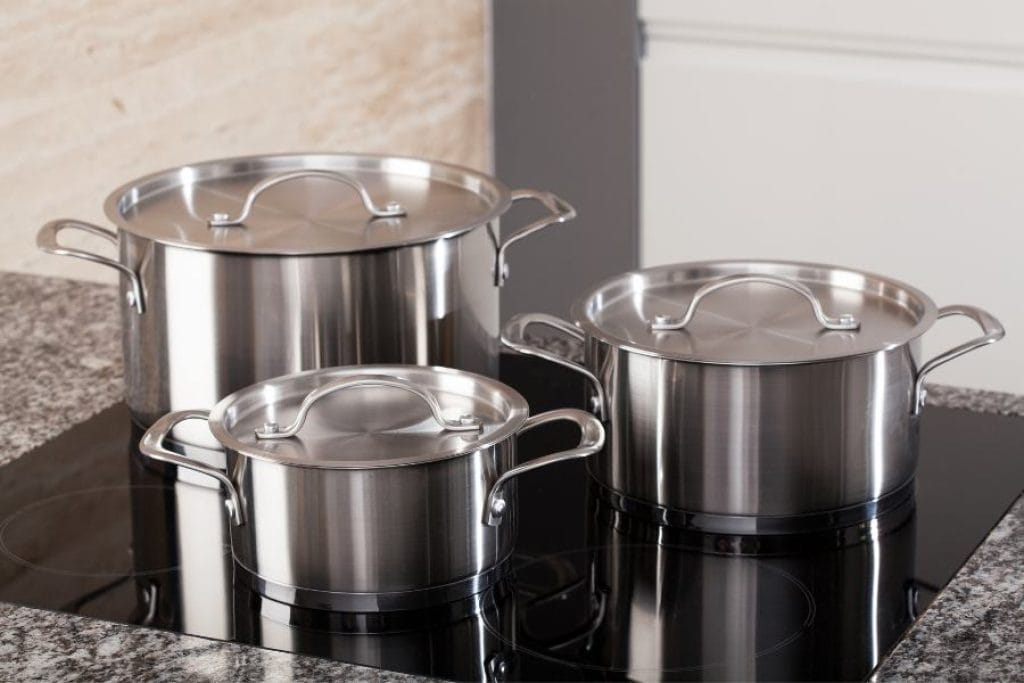
Auto Cut Off/ Shut Down
In-built smart sensors of induction cooktops make them one of the safest options in cooking appliances. Automatic shut down features turn the stove off if it’s running continuously for two hours without any abnormal changes in temperature or power.
Automatic Pan Detection
Induction cooktops can also detect if there is no cookware in the heating zone. This feature makes beeping signals for 30 seconds. If the stove still remains undetected, it automatically cuts off the power.
Overheating Protection
All kinds of induction stoves are equipped with overheating protection features. In case of excessive use, this feature automatically turns off the heating element of the cooking zone and doesn’t let the ceramic glass and other components overheat.
Cool-to-touch Surface
Electromagnetism induces heat on the cookware placed on the induction cooktop. The heat remains limited to the cooking zone and does to transfer to the stove’s ceramic glass surface. That’s why you can touch the stove top while cooking without burn accidents.
Apart from these safety functions, if any liquid spills on the induction stove, a overflow protection turns itself off to prevent damage.
Reputed Brands Manufacturing Induction Stoves
Philips
When it comes to electronic appliances, very few brands can match the standard of Phillips. Their range of induction stoves is one of the best there is. They are durable, sleek, and lightweight. The modern induction stoves by Philips have upgraded features and are designed keeping sustainability factors in mind.
Available in both single and multiple elements, buyers can choose from button control or touch panel designs. Induction stoves from this favorite brand of ours are available in moderate to high price ranges.
Prestige
Another beloved brand Prestige’s induction cooktops are especially famous for their compact and lightweight design. Prestige inductions are one of the more affordable options in the market, Which come with Indian cooking modes. Its aerodynamic cooling system helps in maintaining an optimum working temperature.
Bajaj
Bajaj induction stoves and hobs are more on the affordable range of cooking appliances. This trusted brand sells induction stove models with both button control panels and touch control panels. The maximum wattage of single element Bajaj induction stoves ranges from 1200 watts to 2100 watts. Auto shut-off triggers in only 1 minute. Most Bajaj induction cooktops 6 to 7 preset cooking modes depending on the model.
It also comes with child lock mode for additional safety. Typically designed for the Indian users, the preset modes accommodate a range of Indian cooking styles. The weight of Bajaj cooktops ranges from 700 grams to 3 Kg. Considering the price, Bajaj induction stoves provide good durability, efficiency, and style.
Butterfly
Butterfly induction stoves are mostly available with touch amd button control panels. The brand offers a 1.5-meter power cord with 3 pin plug for safety and convenience. With a strong and durable body made of ABS/PPCP plastic, Butterfly induction stoves will be your trusted everyday kitchen companion. The crystal glass top is pretty tough, sturdy, and easy to clean.
Pigeon
Most pigeon induction cooktops have dual heat sensors to enable faster cooking. The feather-touch panel is user-friendly. Control panels include one-touch access to 7 different Indian menus. The worktops in most designs are made of carbon steel. Pigeon induction cooktops also support timers.
Another perk of the Pigeon induction stove is that it comes with 93% energy-saving technology. Want a sleek induction stove that is efficient and also affordable? Go for the Pigeon induction stoves.
Usha
Most Usha induction cooktops sport a simple design, focusing on durability and efficiency. Another trait of Usha induction stoves is the clear markings for placing the induction cookware. The induction cooktop of this brand strikes a good balance between efficiency, durability, features, and price, making it an ideal choice for Indian kitchens.
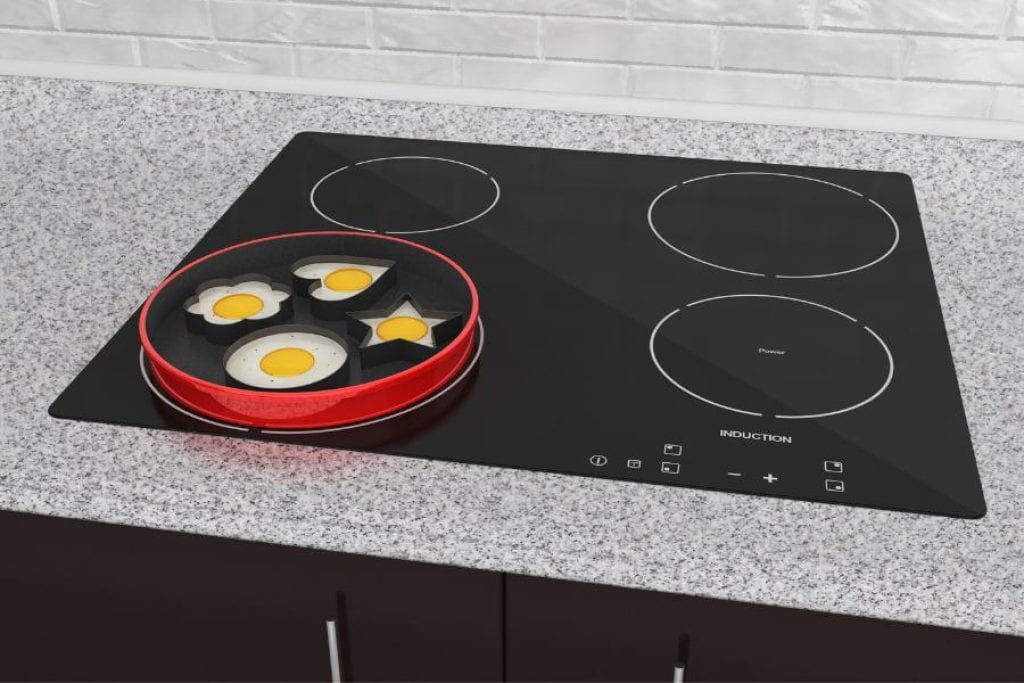
Benefits of Induction Cooktop
1. More Energy-efficient
Gas stoves and traditional electric burners tend to heat up not only the cookware but also the surrounding air. On the other hand, induction cooktops keep the heat limited to the cooking area at the center.
According to stats, induction stoves heat the cooking pot 25% to 50% faster than the alternatives without wasting much energy. This is why induction cooktops are very energy efficient. An interesting fact is that nearly 90% of the energy produced by an induction stove is transferred to the cooking food.
If we compare instructions with regular gas or electric stoves, induction stoves only use 74% of the energy of a standard electric stove and 40% of a gas stove for cooking.
2. Low Maintenance
Induction cooktops are much easier to clean than other stoves. You have to reassemble gas stoves after every cleaning. But induction stoves’ sleek and smooth surface needs no such time-consuming routine. While installation for traditional stoves can be quite heavy on the pocket, induction stove installation is cheap and takes little to no time.
3. Environmentally More Sustainable
An induction cooktop is faster than your regular cooking appliance and consumes much less energy. This makes it one of the most sustainable stoves on the market. As induction stoves work on electricity and need lesser energy than an electric stove, they can be easily powered by renewable energy sources like solar panels.
4. Safer Option Than Traditional Stoves
An induction stove unit doesn’t heat up itself and only limits the generated heat to the cookware. Hence, the whole surface of the cooktop doesn’t heat up. This high quality decreases the chances of accidental burns. You can touch the induction stove with the power on, and you still wouldn’t get burnt.
If there is no cookware on the stove, the auto-shutdown feature detects and turns off the stove. Such safety features make it an ideal cooking appliance, especially for families with children. Some of these induction cookware can be used on gas stoves too.
5. More Cost-effective
With the recent hike in fuel prices, using a gas stove on a daily basis has become quite hefty for middle-class Indians. Using traditional stoves would take up a big chunk of your regular electricity consumption. On the other hand, you can use an induction stove for much lesser energy as electricity is cheaper than fuel in most regions of India!
6. Portable and Easy to Use
Due to their compact size, single-element induction stoves can easily fit in small kitchen spaces. They are lightweight and can easily be carried from one place to another. The induction stove’s light, compact design is ideal for people who move around quite a bit or have small cooking spaces.
Limitations of Induction Stove
1. Health-related Limitation
As induction stoves function on an electromagnetic field, people with pacemakers should avoid using them. The user need to maintain at least 2 ft. distance to stay safe with pacemakers. However, as it is risky, users with pacemakers should avoid using an induction stove.
Pacemakers are small electrical devices that regulate electrical activity in the heart. Anything that produces a strong electromagnetic field can interfere with a pacemaker.
Dr. Mike Knapton at British Heart Foundation
2. Cookware Incompatibility
Only cookware made of ferromagnetic materials is compatible with induction stoves, limiting the usage of a wide range of cooking pots. So if you get an induction stove as your primary cooking appliance, your older cooking vessels might need replacement.
3. Expensive
While single-element induction stoves are available in the affordable range, multi-element or built-in induction cooktops cost big bucks. It also takes time to get the hang of it.
4. Time-taking For Beginners
If you are an amateur in induction hobs, the chances are that you will go through a learning curve before you manage all the features efficiently. Even though there are in-built modes for different cooking methods, it takes time to learn what temperature works in preparing which recipe.
5. More Prone To Wear and Tear
While cleaning an induction cooktop is fairly easy, scratches on the surface will be more frequent if not careful. On the other hand, alternatives like a gas stove or an electric stove are far more tolerant to such wear and tear.
6. Noise Generation
The cooling fan makes substantial noise while cooking on an induction cooktop. Unlike traditional gas stoves, this noise can be annoying to some users.
Like everything in life, induction cooktops have their set of perks and limitations. But considering the decreasing space in households, a compact alternative to our regular cooking appliance seems like a good idea. The bottom line is, even though induction stove might take some getting used to, its energy efficiency, safety features, and top-notch heat control steal the deal as one of the most desirable cooking appliances in today’s time.

